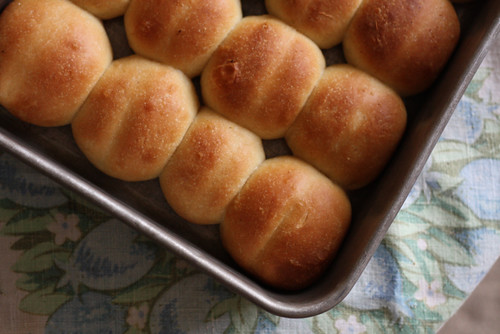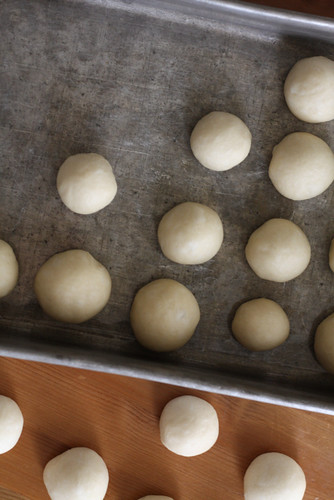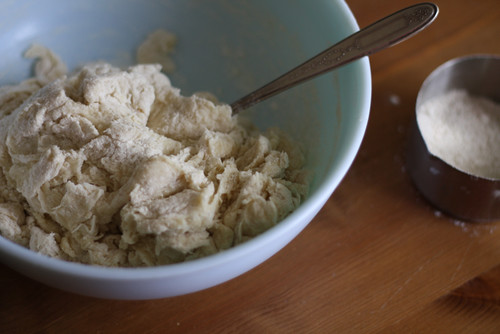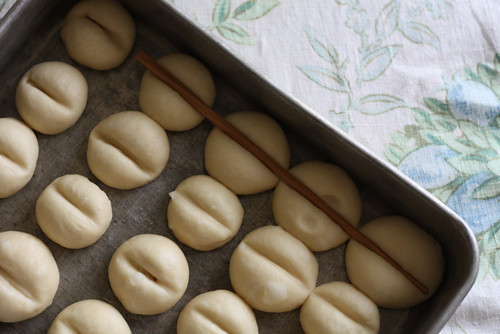Ok. I’ve come to terms with the fact that I have housewife tendencies. It’s true. Don’t judge me… that would be rude.
I’ve tried to ignore these urges. I’ve tried to pass it off as a phase… but really? This can’t go on. I’m going to have to own my housewife tendencies. Now seems like as good a time as ever to fess up.
See… yesterday afternoon I put on my frilly 1950’s apron, pulled my hair back, put on my giant fake pearl earrings and made homemade dinner rolls. The apron and pearls are essential, so is a cigarette and a stiff cocktail if I’m to believe what I see on Mad Men.
So there I am in my kitchen, proudly clad in my housewife gear, hand kneading some pretty sexy roll dough, thinking I’ve got it pretty kush when I realize that my housewife fantasy is missing two things… a… um… er… husband… and mud covered children that I have to chase around the house to get into the bath.
So. Ok. Fine. My housewife tendencies are really just an excuse for me to play dress up for an afternoon. And rolls and butter? Just the awesome perk of my extended dress up games.
Pretty pretty dinner rolls. This luscious dough comes together with just ten minutes of hand kneading. They’re buttery and sweet, and have some thickness and weight without being dry and boring. They’re so lovely. You’ll feel all sorts of impressed with your abilities.
This recipe is a classic. Parker House Rolls are said to have originated in the 1870’s (whaaaat!?) at the Parker House Hotel in Boston. Old school.
keepin’ it real.
Parker House Rolls
recipe from The Gourmet Cookbook
makes 20 rolls
3 tablespoons warm water (105 to 115 degrees F)
3 tablespoons sugar
1 (1/4-ounce) package (2 1/2 teaspoons) active dry yeast
1 stick (8 tablespoons) unsalted butter
1 cup whole milk
2 cups bread flour
1 1/2 teaspoons salt
3/4 – 1 1/2 cups all-purpose flour
Stir together warm water, 1 tablespoons sugar and yeast in a small bowl until yeast in dissolved. Let stand until foamy, about five minutes. If the mixture does not foam up, throw it out and start over with different yeast. Foam means that the yeast is livin’.
Melt 3/4 stick (6 tablespoons) butter in a small saucepan. Add the milk and heat until lukewarm. Pour into a large bowl and add yeast mixture, remaining 2 tablespoons of sugar, bread flour, and salt. Stir with a wooden spoon until just combined.
Stir in 3/4 cup all-purpose flour, dump out onto a clean work surface and begin to bring the dough together into a ball. If your dough is too sticky to handle, add up to 1/2 cup of all-purpose flour a tablespoon at a time until the dough is just slightly sticky.
Knead dough until a smooth and elastic dough begins to form, adding more all-purpose flour as needed. The dough will be smooth, satiny and just slightly sticky after 10 minutes. Good job! Form dough into a ball and place in a large, buttered bowl, turning the dough so that the entire ball is covered. Cover with plastic wrap and a towel and let rest n a warm, draft free place until doubled in size, about 1 hour.
Butter a 9×13-inch baking pan. Divide dough into 20 equal pieces. Roll each one into a ball and arrange evenly in 4 rows of 5 in a baking pan. Cover loosely with plastic wrap and let rise in a warm, draft free place until almost doubled in size, about 45 minutes.
Using a floured chopstick or the edge of a ruler, make a deep crease down the center of each row of rolls. Let rolls rise, loosely covered for 15 minutes.
Preheat oven to 375 degrees F and place a rack in the center of the oven.
Melt the remaining 2 tablespoons of butter and cool slightly. Brush the tops of the rolls with butter and place in the oven for 20-25 minutes, until golden brown. Cool rolls in the pan for 5 minutes then remove and serve warm. Reheat rolls wrapped in foil in a 375 degree oven if you’d like to eat them the next day with butter and jam. Serious yum.









182 Responses
I love bread!
I have a dinner roll question. I’ve got my dough ready to roll into balls now. I’ve heard that you can roll the balls and then freeze them to bake off later… My question is, do I put the dough balls in the freezer before or after letting them rise? My rolls are for Thanksgiving next week, was hoping to just defrost and bake them the day of but I’m not sure if I need to let them rise, then freeze, or just make the balls, put in a greased pan, and straight into the freezer.
Does my question make sense? Thank you!!!
I made these yesterday for Christmas dinner. They were so simple to make and incredibly tasty. I even messed up by using the whole stick of butter in the dough, and by adding a pinch or two of flour to get the right consistency, it didn’t matter at all. Great recipe! Thanks!
is it critical to use whole milk? I just opened a jug of 2% milk and would love to use that if possible!
2% will be just fine, Jen. Go on with your bad self and make these rolls!
Any recipe for potato rolls
Do these rolls freeze well? I’m hoping to make them then travel with them for Thanksgiving.
If I wanted to make these three day before I bake them, what step would you recommend I stop at? After they’re formed in the pan?
Help! Can I make with only AP flour?
yes you can!
Could you make and bake later? Possibly freeze?
Yes, you can!
What kind of salt is called for here, Joy? Table? Kosher?
This recipe is now my go-to for dinner rolls! It stays soft for days, and is nice and chewy. If you make these rolls often, try buying bread flour. Also, some alterations I make to this recipe, is using entirely bread flour, and around a 1/4 more flour than the recipe calls for.
It says there are 179 comments – why can I see just one?
I was hoping someone else had tried this with instant yeast rather than active dry.
Awesome video on how to make rolls perfectly round! https://youtu.be/Gx2Sf3XqkhQ?si=fxt8_Ite3unnSeWf
BEST ROLLS EVER! JOOY THE BAKER IS AMAZING